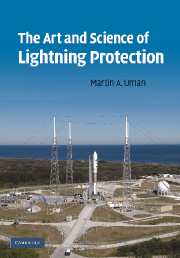Book contents
- Frontmatter
- Contents
- Preface
- 1 What is lightning?
- 2 Lightning damage
- 3 General methods for lightning protection: Faraday cages, topological shields; and more practical approaches: cone of protection and rolling sphere methods
- 4 Structure protection: air terminals and down conductors
- 5 Structure protection: grounding
- 6 Surge protection for electronics in low-voltage electrical systems
- 7 Humans and animals
- 8 Lightning warning
- 9 Airships, airplanes, and launch vehicles
- 10 Ships and boats
- 11 Trees
- 12 Overhead and underground power and communication lines
- 13 Lightning elimination
- 14 So, what do we know and what don't we know about lightning protection?
- Index
- References
3 - General methods for lightning protection: Faraday cages, topological shields; and more practical approaches: cone of protection and rolling sphere methods
Published online by Cambridge University Press: 17 November 2009
- Frontmatter
- Contents
- Preface
- 1 What is lightning?
- 2 Lightning damage
- 3 General methods for lightning protection: Faraday cages, topological shields; and more practical approaches: cone of protection and rolling sphere methods
- 4 Structure protection: air terminals and down conductors
- 5 Structure protection: grounding
- 6 Surge protection for electronics in low-voltage electrical systems
- 7 Humans and animals
- 8 Lightning warning
- 9 Airships, airplanes, and launch vehicles
- 10 Ships and boats
- 11 Trees
- 12 Overhead and underground power and communication lines
- 13 Lightning elimination
- 14 So, what do we know and what don't we know about lightning protection?
- Index
- References
- Type
- Chapter
- Information
- The Art and Science of Lightning Protection , pp. 43 - 64Publisher: Cambridge University PressPrint publication year: 2008



